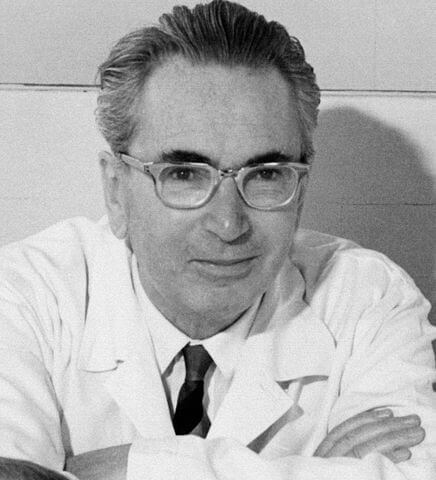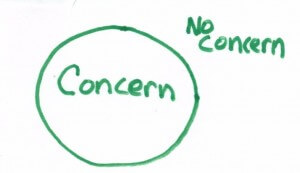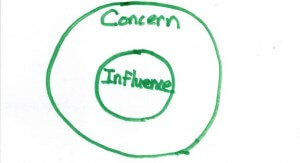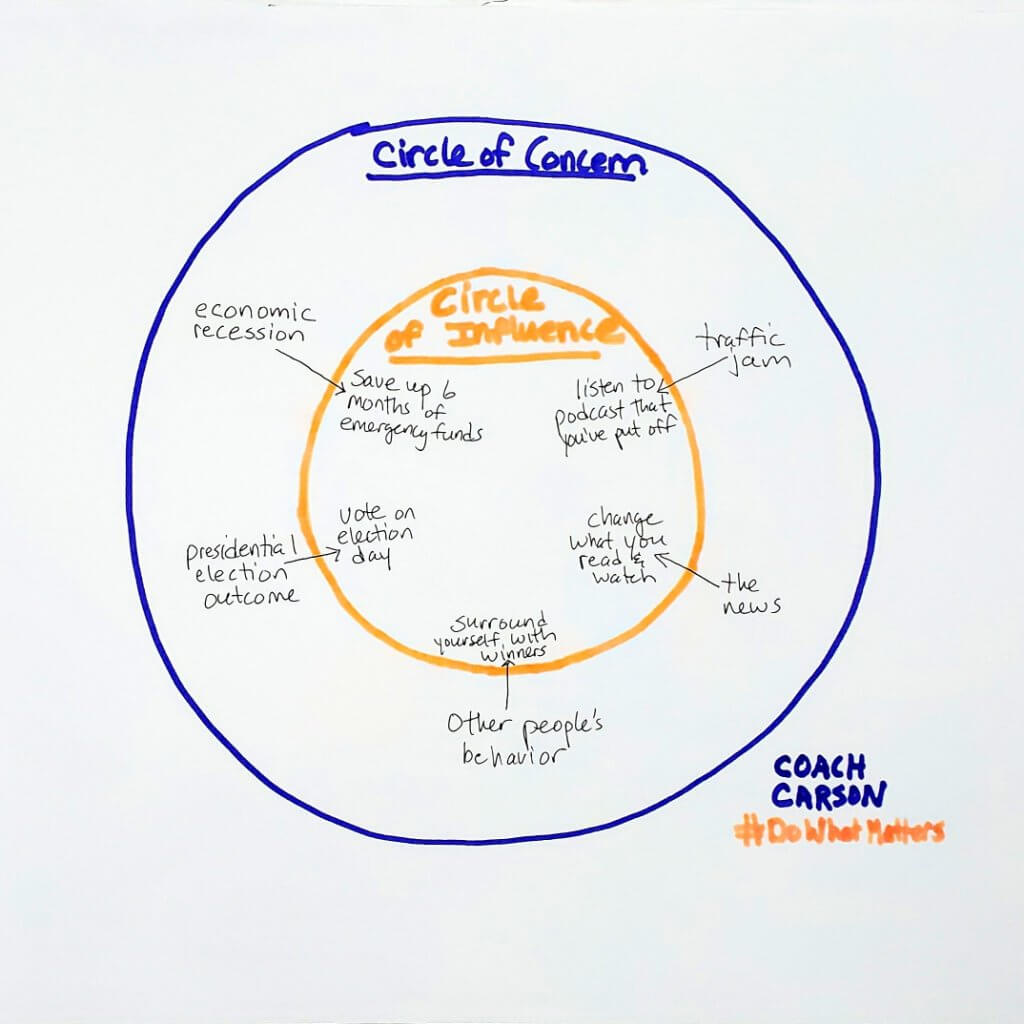We all worry and stress about something. It’s part of human nature.
But the most effective, wise, and happy people handle the stresses of life differently than the rest of us. They focus their time and energy on things they can control, and they seek some kind of serenity on the things they can’t.
The organization Alcoholics Anonymous uses the Serenity Prayer to help its members:
God, grant me the serenity to accept the things I cannot change,
The courage to change the things I can,
And the wisdom to know the difference.”
Another way of expressing the beautiful idea in this prayer is that wise people focus more on their “Circle of Influence” and not only on their “Circle of Concern.”
The rest of this article will explain what that means.
The Circle of Concern vs The Circle of Influence
I originally learned this idea from one of my favorite books, The 7 Habits of Highly Effective People by Stephen R. Covey.
Think of all of the events or situations in your life that concern you. Now imagine collecting all of these concerns into one big circle called the Circle of Concern. Everything inside the circle is of concern to you, and everything outside of the circle of no concern to you.
The problem with this circle is that many of the things you are concerned about are outside of your control.
For example, you may be worried about the health of a family member. You may be concerned about the economy. You may be frustrated with a difficult colleague at work.
Within your larger Circle of Concern, there are some situations within your control or influence. These we could put inside of another circle called the Circle of Influence.
For example, you might be worried about the stability of the overall economy (Circle of Concern). But what about the economy is within your Circle of Influence? In other words, what can you DO about it?
Here are a few ideas:
- Save up extra cash reserves for financial security in case of an economic downturn
- Think of ways to make yourself extra valuable or even indispensable at work to give yourself job security
- Buy the products or services of your favorite but struggling businesses to support them in a tough economy
Don’t these ideas feel much better than simply telling yourself “I’m worried about the economy?” When you focus within your Circle of Influence, you become more empowered, more positive, and more confident about the events in your life.
The opposite is true when you only focus outside of your Circle of Influence in the Circle of Concern. In that space, you tend to complain, react, blame, and gossip. You also tend to feel helpless and out of control, which is the source of much of our stress and anxiety.
One man learned these lessons the hardest way imaginable inside the barbed wire of a concentration camp during World War II.
The Last of Human Freedoms

Viktor Frankl called optimism “the last of human freedoms.” He would know. During World War II, Frankl lost just about every personal freedom as the Nazis in Germany killed his family and imprisoned him in some of the most horrible conditions imaginable within concentration camps.
But Viktor Frankl survived the Holocaust and became a real-life illustration of the power of focusing on your Circle of Influence.
Frankl obviously had some legitimate and serious issues within his Circle of Concern. Even worse, he had a tiny Circle of Influence because he had so few personal freedoms within a concentration camp.
What did Frankl decide to do?
Frankl focused on the LAST thing left in his Circle of Influence, his inner mind. More specifically, Frankl focused on the meaning he gave to his current situation.
The Nazis could imprison him, abuse him, starve him, and work him nearly to death, but only Frankl could choose to let them control the meaning of these events.
Finding Meaning Inside a Concentration Camp
Frankl had been a psychiatrist and teacher before being imprisoned. He knew that he possessed skills to help others within the camp to face the horrors of their situation. He also knew that if he survived, these experiences could be powerful teaching stories to help future patients, students, and audiences.
Frankl decided to focus on his Circle of Influence, and it literally made the difference between life or death for him.
He began by working on the person he had the most control over, himself. Simply realizing that he still had this last of human freedoms, optimism, changed his attitude and his entire outlook.
He could imagine the people he could help someday by sharing this experience. He could also see right away the people he could help in the concentration camp.
Frankl’s attitude and actions were noticed by the people around him. He became a source of hope and comfort for others. His circle of influence began in a small place within his mind, but it quickly expanded to people around him, both prisoners and guards!
And after the war and the liberation from the concentration camps, Frankl’s Circle of Influence continued to grow and spread around the world through books, speaking invitations, professorships, and more. Amazingly, his Circle of Influence continues to grow even today as you and I read about his story and make changes in our lives.
This amazing story all began with Frankl’s courageous decision to shift his focus from his Circle of Concern to his Circle of Influence.
That courageous choice is something you and I can make as well.
Decide Like a Stoic: Direct, Indirect, or No Control
“The chief task in life is simply this: to identify and separate matters so that I can say clearly to myself which are externals not under my control, and which have to do with the choices I actually control.”
– Epictetus, Discourses (as translated in The Daily Stoic: 366 Meditations on Wisdom, Perseverance, and the Art of Living)
I’m an enthusiastic student of Stoicism, an ancient philosophy concerned with the art of living. The central idea of Stoicism is to identify the things you can control and others you can’t control.
A more helpful application of this Stoic idea is to further divide the events of your life into three categories:
- Direct Control
- Indirect Control
- No Control
Like the wisdom of the Serenity Prayer, this approach gives you the satisfaction of always being able to do something. Here’s how:
Direct Control:
These problems are directly within your control because they are related to your own habits and behaviors.
For example, I tend to go through cycles where I don’t sleep enough, my body gets worn down, and I get sick. Although I have legitimate excuses (don’t we all), I can still control this problem directly by deciding:
- when I turn off the computer
- when I start winding down for bed
- what type of reading I do before bed
- when I turn off the lights
For the last few years, I’ve gradually implemented a “digital sunset” which originally began at 11 pm and has now moved to 10 pm. It hasn’t been easy! But by focusing on my decisions and behaviors, the challenge of getting better sleep has improved.
Indirect Control
These problems are not within your direct control because other people are involved. With indirect control, you must work on your relationships and your communication with others. The best you can do is change your methods of influencing others.
The first example that comes to mind here is parenting! Oh how I sometimes wish that I could control my children’s behaviors, but oh how clearly do they remind me that they have minds of their own!
Whether it’s your children, a spouse, a partner, a boss, customers, or lenders, people in your personal and professional life are outside of your direct control. At best, you can influence them with your carefully chosen words and actions.
You could call this practice of indirect control the art of persuasion. But keep in mind the wisdom of Ralph Waldo Emerson when you choose your method of influence:
“What you do speaks so loudly that I cannot hear what you say.”
In other words, your life is the greatest lecture. The integrity and congruence of your words and your actions will influence people the most over the long run.
No Control
These are the problems acknowledged in The Serenity Prayer: “grant me the serenity to accept the things I can not change.”
You may not have direct or indirect control over these problems, but like Victor Frankl found out, you can decide the meaning of these events. You can also decide to respond with hope or with dejection.
As Stephen Covey again wisely counsels:
No control problems involve taking the responsibility to change the line on the bottom [of] our face – to smile, to genuinely and peacefully accept these problems and learn to live with them, even though we don’t like them.”
As Viktor Frankl’s life so eloquently showed, there are times when the no control problems force us to make the most powerful changes within ourselves.
What’s Inside Your Circle of Influence?
The most powerful ideas are those that you can apply immediately within your life to make improvements.
So I leave you with these questions:
- What are you concerned about? What problems in our life are causing stress and anxiety?
- Which problems are within your direct control? Indirect control? No control?
- In all cases, what are the next actions you can take right away within your Circle of Influence?
- If a problem is outside of your control, can you acknowledge and accept that? Can you ask for the serenity to help you find peace with it?
These are not easy questions or tasks. I’ll be repeating them for myself right alongside you!
But I also know that actually doing this exercise is a wonderfully empowering and freeing process. So, as soon as you can, write down the problems in your Circle of Concern and identify the actions that are still within your Circle of Influence.
And if all else fails, follow the example of Viktor Frankl and search within yourself for that last of human freedoms, the ability to choose your attitude and perhaps even to smile in spite of the world around you.
Thank you for giving me your time and attention. I’d love to hear your thoughts and comments in the comment section below.
Get My Free Real Estate Investing Toolkit!
Enter your email address and click "Get Toolkit"



Loved the pictures about Circle of Concern, No Concern, and Influence! It’s been awhile since I read Stephen Covey’s book, so this is a very timely message. I found myself upset and worrying late last night about something in my circle of concern for a family member, but having very little influence. I just took your advice and drew my Circle of Concern, Influence, and listed 5 steps that I can help them with. Thank you for the great perspective and advice!
Wow, thanks for sharing your story, Sylvia. I am really glad the ideas helped you. I have found them to make me feel better as well, especially in situations that seem out of our control.
Thank you very much! Found this blog very useful and interesting!
Glad to hear it! Thank you for visiting and for commenting.
Thank you for this post and reminder to focus on things we CAN control in order to preserve our mental health and well-being. We often feel that worrying about something will somehow will keep us accountable and make us take action, but ultimately it’s counterproductive (at best) and debilitating (at worst). I plan to do this exercise today. Thanks, Coach!
Glad you’re doing the exercise, Regina! Thanks for the feedback, and I totally agree on your comment about worry.
I believe that everyone in the world should read this book – especially Real Estate Investors. Of course we have to master habits 1 through 3 in order to get to the next ones, but habits 4 + 5 are Essentials for putting together deals. If anyone wants to do real estate at a high level or get involved in the creative financing side, I believe that it is mandatory that they read this book, specifically have is 4 + 5 along with being proactive.
Yeah, this book is so helpful Julian. Agree. And I have yet to find a book whose interpersonal skills are as helpful for business and life as this one. Think win-win, seek first to understand. Those will take you a long way.
Thank you very much Chad for sharing your perspective on what matters, especially during these times filled with uncertainty.
Thanks Matias! Always good to hear from you.
I suffer depression and find the circles of concern, influence and control a necessary tool for my mental health. I keep it posted in my kitchen and its ever evolving. When my negative or worrisome thoughts arise referring to my circles is a grounding reminder whats most important Me, the center of my circles.
Great summary of Covey’s circles!
I just recently wrote a post about this too, mostly focusing on the misnomer that gets passed around—the “circle of control”. Not something that was part of this book 🙂
However, I do think it’s interesting that a lot of focus popularly around the circle of concern/influence is the idea of *shrinking* your circle of concern.
At least as I read it, I feel like Covey’s intention was at least 50% to get people to expand their circle of influence (in order to reduce what falls in their concern, rather than just throwing it out).
What do you think about that?
Cheers!
In spite of reading repeatedly on Circle of control/influence/no control, we still allow our mind to slip on the circle of concern / No control, like how we slip through the negatives of our life. Now I made it a practice & teach my children also; that every task we are undergoing & going to undertake, will first analyze whether I am in circle of control now & remain in future through the process of task. Then only take up/ go ahead if implementing it.. It applies to every situations / Tasks we go through in our life & thus avoid a stress / frustrations / depression / disappointments in our day to day life.
The text is very helpful – I am currently looking for a job – and within the pandemic, this is a tough task. But I can control where I apply and I am in full control of my supporting documents – so I can do my job – and I must let go the email or send button – and hope for the other side to react.
Also, I am in control of my free time – in contrast to the previous manager routine – and I use it as well as possible – allowing myself space for new thoughts.
Stephan / Frankfurt / Germany